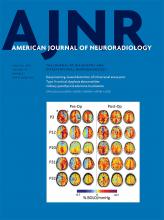Table of Contents
Perspectives
Practice Perspectives
General Contents
- Deep Learning–Based Detection of Intracranial Aneurysms in 3D TOF-MRA
In a retrospective study, the authors established a system for the detection of intracranial aneurysms from 3D TOF-MRA data. The system is based on an open-source neural network, originally developed for segmentation of anatomic structures in medical images. Eighty-five datasets of patients with a total of 115 intracranial aneurysms were used to train the system and evaluate its performance. Manual annotation of aneurysms based on radiologic reports and critical revision of image data served as the reference standard. The highest overall sensitivity of this system for the detection of intracranial aneurysms was 90% with a sensitivity of 96% for aneurysms with a diameter of 3–7 mm and 100% for aneurysms of >7 mm. The best location-dependent performance was in the posterior circulation.
- Radiomics-Based Intracranial Thrombus Features on CT and CTA Predict Recanalization with Intravenous Alteplase in Patients with Acute Ischemic Stroke
Sixty-seven patients with ICA/M1 MCA segment thrombus treated with IV alteplase were included in this analysis. Three hundred twenty-six radiomics features were extracted from each thrombus on both NCCT and CTA images. Linear discriminative analysis was applied to select features most strongly associated with early recanalization with IV alteplase. These features were then used to train a linear support vector machine classifier. Thrombus radiomics features derived from NCCT and CTA are more predictive of recanalization with IV alteplase in patients with acute ischemic stroke with proximal occlusion than previously known thrombus imaging features such as length, volume, and permeability.
- Improved White Matter Cerebrovascular Reactivity after Revascularization in Patients with Steno-Occlusive Disease
Thirty-five patients with steno-occlusive disease (Moyamoya disease [n = 24], Moyamoya syndrome [n = 3], atherosclerosis [n = 6], vasculitis [n = 1], and idiopathic stenosis [n = 1]) who underwent unilateral brain revascularization using a direct superficial temporal artery–to-MCA bypass were evaluated. WM cerebrovascular reactivity was measured preoperatively and postoperatively using BOLD MR imaging during iso-oxic hypercapnic changes in end-tidal carbon dioxide. WM cerebrovascular reactivity significantly improved after direct unilateral superficial temporal artery–to-MCA bypass in the revascularized hemisphere in the MCA territory and in the anterior cerebral artery territory.
- MRI Quantitative T2* Mapping to Predict Dominant Composition of In Vitro Thrombus
Thirty-five thrombus analogs of different compositions were scanned with an MR imaging quantitative T2* mapping sequence. Two radiologists, blinded to thrombus composition, measured the thrombus-T2* relaxation time twice, at an interval of 2 weeks. Quantitative histologic evaluations of red blood cell content were performed. Inter- and intraobserver reproducibility of the thrombus-T2* relaxation time was assessed by calculating intraclass correlation coefficients. MR imaging quantitative T2* mapping can reliably identify the thrombus red blood cell content in vitro. This fast, easy-to-use sequence could be implemented in routine practice.
- Two-Layered Susceptibility Vessel Sign and High Overestimation Ratio on MRI Are Predictive of Cardioembolic Stroke
Two characteristics of the susceptibility vessel sign, overestimation ratio (overR), a quantitative evaluation of the susceptibility vessel sign, and the 2-layered susceptibility vessel sign (TL-SVS), were reported to predict cardioembolic stroke. These 2 biomarkers, on 1.5T or 3T systems (159 and 101 patients, respectively), demonstrated high specificity (0.77 at 1.5T and 1 at 3T) and their simultaneous presence is highly associated with cardioembolism.
- Determinants of Deep Gray Matter Atrophy in Multiple Sclerosis: A Multimodal MRI Study
Seventy-seven patients with MS and 44 healthy controls were enrolled in this cross-sectional study. MR imaging investigation included volumetric, diffusion tensor imaging, perfusion weighted imaging, and Quantitative Susceptibility Mapping analyses. Deep gray matter structures were automatically segmented to obtain volumes and mean values for each MR imaging metric in the thalamus, caudate, putamen, and globus pallidus. Patients with MS showed a multifaceted involvement of the thalamus and basal ganglia, with significant atrophy of all deep gray matter structures. In the relapsing-remitting MS group, WM lesion burden proved to be the main contributor to volume loss for all deep gray matter structures.



